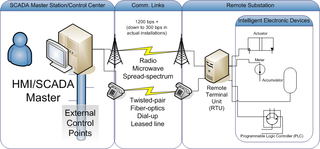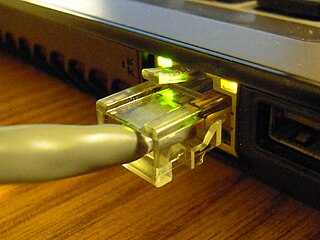Clock synchronization is a topic in computer science and engineering that aims to coordinate otherwise independent clocks. Even when initially set accurately, real clocks will differ after some amount of time due to clock drift, caused by clocks counting time at slightly different rates. There are several problems that occur as a result of clock rate differences and several solutions, some being more appropriate than others in certain contexts.

DNP3 is a set of communications protocols used between components in process automation systems. Its main use is in utilities such as electric and water companies. Usage in other industries is not common. It was developed for communications between various types of data acquisition and control equipment. It plays a crucial role in SCADA systems, where it is used by SCADA Master Stations, Remote Terminal Units (RTUs), and Intelligent Electronic Devices (IEDs). It is primarily used for communications between a master station and RTUs or IEDs. ICCP, the Inter-Control Center Communications Protocol, is used for inter-master station communications. Competing standards include the older Modbus protocol and the newer IEC 61850 protocol.
Profinet is an industry technical standard for data communication over Industrial Ethernet, designed for collecting data from, and controlling equipment in industrial systems, with a particular strength in delivering data under tight time constraints. The standard is maintained and supported by Profibus & Profinet International, an umbrella organization headquartered in Karlsruhe, Germany.
EtherCAT is an Ethernet-based fieldbus system, invented by Beckhoff Automation. The protocol is standardized in IEC 61158 and is suitable for both hard and soft real-time computing requirements in automation technology.
A Protocol Converter is a device used to convert standard or proprietary protocol of one device to the protocol suitable for the other device or tools to achieve the interoperability. Protocols are software installed on the routers, which convert the data formats, data rate and protocols of one network into the protocols of the network in which data is navigating. There are varieties of protocols used in different fields like power generation, transmission and distribution, oil and gas, automation, utilities, and remote monitoring applications. The major protocol translation messages involve conversion of data messages, events, commands, and time synchronization.
IEC 60870 part 6 is one of the IEC 60870 set of standards which define systems used for telecontrol in electrical engineering and power system automation applications. The IEC Technical Committee 57 have developed part 6 to provide a communication profile for sending basic telecontrol messages between two systems which is compatible with ISO standards and ITU-T recommendations.
Generic Substation Events (GSE) is a control model defined as per IEC 61850 which provides a fast and reliable mechanism of transferring event data over entire electrical substation networks. When implemented, this model ensures the same event message is received by multiple physical devices using multicast or broadcast services. The GSE control model is further subdivided into GOOSE and GSSE.

Audio Video Bridging (AVB) is a common name for the set of technical standards developed by the Institute of Electrical and Electronics Engineers (IEEE) Audio Video Bridging Task Group of the IEEE 802.1 standards committee. This task group was renamed to Time-Sensitive Networking Task Group in November 2012 to reflect the expanded scope of work.
PTPd is an open source implementation of the Precision Time Protocol for Unix-like computers.
RAPIEnet is Korea's first Ethernet international standard for real-time data transmission.
White Rabbit is the name of a collaborative project including CERN, GSI Helmholtz Centre for Heavy Ion Research, and other partners from universities and industry to develop a fully deterministic Ethernet-based network for general purpose data transfer and sub-nanosecond accuracy time transfer. Its initial use was as a timing distribution network for control and data acquisition timing of the accelerator sites at CERN as well as in GSI's Facility for Antiproton and Ion Research (FAIR) project. The hardware designs as well as the source code are publicly available. The name of the project is a reference to the White Rabbit appearing in Lewis Carroll's novel Alice's Adventures in Wonderland.

Media Redundancy Protocol (MRP) is a data network protocol standardized by the International Electrotechnical Commission as IEC 62439-2. It allows rings of Ethernet switches to overcome any single failure with recovery time much faster than achievable with Spanning Tree Protocol. It is suitable to most Industrial Ethernet applications.
Industrial automation systems consisting of several distributed controllers need a precise synchronization for commands, events and process data. For instance, motors for newspaper printing are synchronized within some 5 microseconds to ensure that the color pixels in the different cylinders come within 0.1 mm at a paper speed of some 20 m/s. Similar requirements exist in high-power semiconductors and in drive-by-wire vehicles. This synchronisation is provided by the communication network, in most cases Industrial Ethernet. Many ad-hoc synchronization schemes exist, so IEEE published a standard Precision Time Protocol IEEE 1588 or "PTP", which allows sub-microsecond synchronization of clocks. PTP is formulated generally, so concrete applications need a stricter profile. In particular, PTP does not specify how the clocks should operate when the network is duplicated for better resilience to failures.





